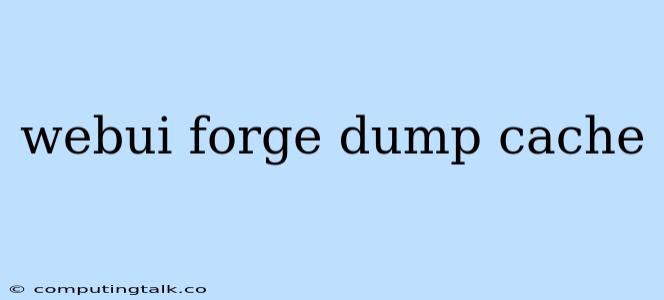Managing Cache in a WebUI Forge: A Comprehensive Guide
Maintaining a clean and efficient cache is crucial for the optimal performance of your WebUI Forge. A cache stores data that your application frequently accesses, allowing it to load faster and respond more efficiently to user requests. However, a poorly managed cache can lead to outdated data, slowdowns, and even errors.
This article explores the importance of cache management in a WebUI Forge, providing insights into common practices, benefits, and techniques to effectively manage your cache.
What is a Cache in a WebUI Forge?
In essence, a cache acts as a temporary storage area for frequently accessed data. When a user requests a specific piece of information from your WebUI Forge, the application first checks the cache. If the data is found in the cache, it is served directly, skipping the time-consuming process of retrieving it from the original source. This significantly reduces loading times and enhances the user experience.
Benefits of Using a Cache
- Faster Loading Times: Caching improves performance by serving data from the cache instead of fetching it from the source, resulting in faster loading times.
- Reduced Server Load: Caching lessens the burden on your server by handling requests directly from the cache, minimizing the number of requests that reach the server.
- Improved User Experience: Faster loading times contribute to a more positive user experience, increasing satisfaction and engagement with your application.
- Enhanced Scalability: A well-managed cache can handle increased traffic without overwhelming your server, making your application more scalable.
Why Cache Dumping is Necessary
While caching offers numerous advantages, it's essential to ensure the data stored in the cache remains up-to-date and relevant. Outdated cached data can lead to inconsistencies, display errors, and frustrate users.
Here's why you need to periodically dump the cache:
- Data Updates: When you make changes to your WebUI Forge, like updating content, adding new features, or fixing bugs, the cached data might become outdated. Dumping the cache ensures that users see the latest changes.
- Data Inconsistency: Sometimes, the cache may contain incorrect or conflicting data. Dumping the cache helps resolve these inconsistencies and ensures data integrity.
- Cache Overflow: Over time, the cache can become full, leading to performance issues. Dumping the cache clears out old data and frees up space for new content.
- Security Considerations: If you're concerned about security breaches, you might want to dump the cache periodically to mitigate potential risks associated with outdated or compromised cached data.
How to Dump Cache in a WebUI Forge
The method for dumping the cache in a WebUI Forge depends on the specific tools and frameworks you use. However, common methods include:
- WebUI Forge Interface: Many WebUI Forges provide dedicated options to clear or flush the cache within the interface.
- Command Line Tools: You can use command-line tools specific to your WebUI Forge's underlying technology (e.g., Nginx, Apache) to manually clear the cache.
- Code Integration: Some WebUI Forges allow you to integrate code to programmatically control the cache, including automated dumping.
Best Practices for Cache Management
- Cache Invalidation Strategies: Develop a clear strategy for how and when to invalidate or refresh cached data.
- Cache Expiration: Implement expiration times for cached data. This ensures that data is automatically removed from the cache after a certain period.
- Cache Size Limits: Set appropriate limits for the cache size to prevent it from consuming excessive server resources.
- Monitoring and Logging: Monitor cache activity, including cache hits, misses, and evictions. This data helps identify areas where caching can be optimized.
- Testing and Verification: Regularly test your caching implementation to ensure that data is being cached, invalidated, and retrieved as expected.
Conclusion
Caching is a crucial component of a high-performing WebUI Forge. By effectively managing your cache, you can enhance loading times, reduce server load, and improve the user experience. However, it's essential to keep the cache clean and updated by periodically dumping it to avoid data inconsistencies and ensure optimal performance. Remember to implement sound caching strategies, set expiration times, and monitor cache activity for continuous improvement.
